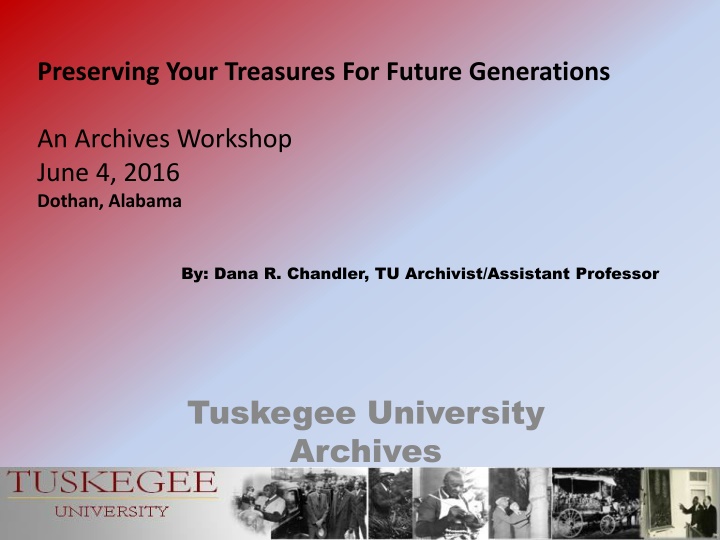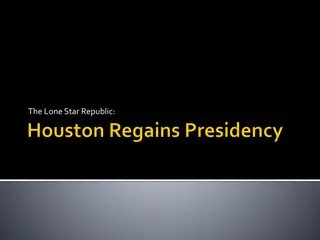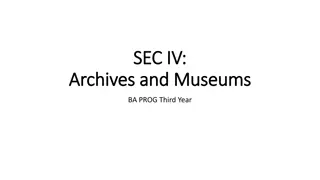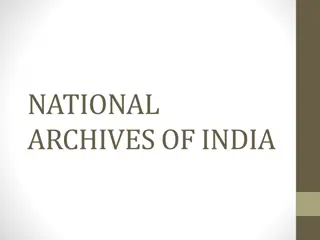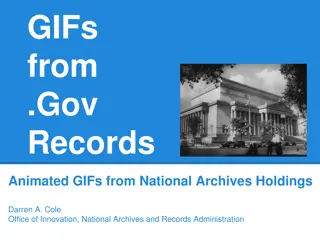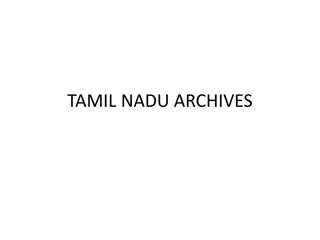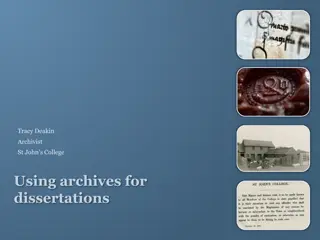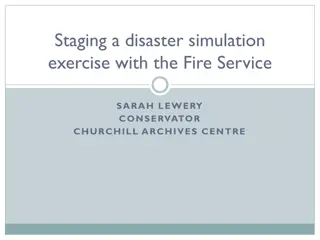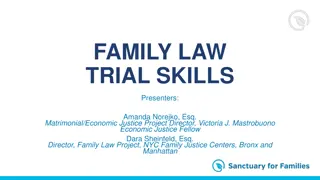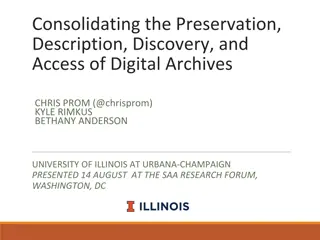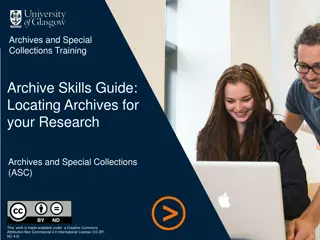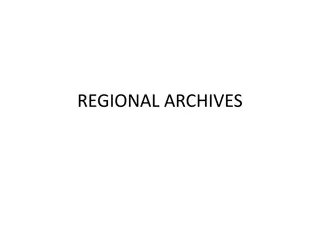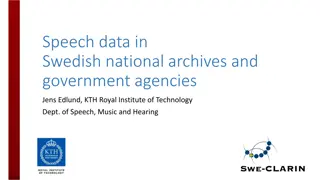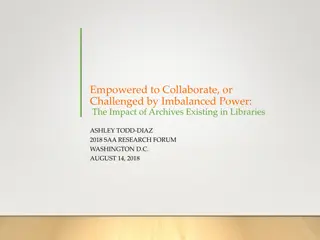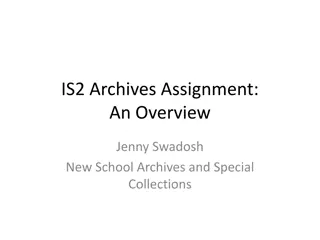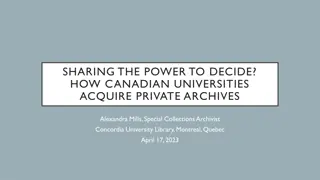Preserving Your Family Archives: A Workshop Guide
Learn how to preserve your family archives for future generations with this workshop guide. Understand the importance of family archives, organizing strategies, types of items to preserve, and major ways to protect collections. Discover valuable insights about storing physical family archives and ensuring their longevity.
Download Presentation

Please find below an Image/Link to download the presentation.
The content on the website is provided AS IS for your information and personal use only. It may not be sold, licensed, or shared on other websites without obtaining consent from the author.If you encounter any issues during the download, it is possible that the publisher has removed the file from their server.
You are allowed to download the files provided on this website for personal or commercial use, subject to the condition that they are used lawfully. All files are the property of their respective owners.
The content on the website is provided AS IS for your information and personal use only. It may not be sold, licensed, or shared on other websites without obtaining consent from the author.
E N D
Presentation Transcript
Preserving Your Treasures For Future Generations An Archives Workshop June 4, 2016 Dothan, Alabama By: Dana R. Chandler, TU Archivist/Assistant Professor Tuskegee University Archives
Why Your Archives Matter Almost everyone has family archives They tell the story of who we are Future generations will have a record of where they came from (answers questions: who, when, where and sometimes why) Family archives tell the story of our communities Family treasures can become national treasures (Amelia Boynton Robinson Collection)
What are Family Archives? May be sentimental, legal, financial They serve as proof that an event occurred, or to explain how something happened A physical collection of books, paper documents, photographs, etc.; or a place where collections are stored Electronic records: email, web sites, databases, sound and images
Organizing Family Archives Identify: writers and receivers should be fully labeled; separate notes are fine; include any other relevant information Organize: Avoid letting the collection get scattered or misidentified
Question What do you have that represents your family archives that you plan to preserve? Books, scrapbooks, diaries and pamphlets Documents (letters, deeds, marriage certificates) Newspapers and newspaper clippings Photographs prints, slides, negatives, film Audio/Video film, discs, cassettes, reel to reel
Major Ways to Protect Collections Control the environment: temperature, humidity, light, dirt and dust Use the right type of enclosures Careful, limited handling Use copies instead of originals ALSO: Protect Against Emergencies (multiple copies)
Questions Where are your physical family archives currently stored? In an attic In a basement or garage In the main part of a house or apartment Offsite (U-storage vault, safety deposit box) Other
Environmental Risks T & RH Temperature: Too hot? For every 10 degrees rise in temperature the rate of deterioration/decay is doubled Relative Humidity: Too high or too low Avoid extremes, including rapid changes in T & RH Ideal: Cool and dry (65-70 degrees Far.; 45 to 50% RH)
Low-Cost Solutions for Minimizing Damage from T & RH Avoid basements and attics Use enclosures to buffer sudden changes in T & RH Store family archives in the central part of the home in boxes, drawers, closets, under beds where T & RH are more stable Seal windows, cracks and crevices Lower the temperature in your home during the winter months
Low-Cost Solutions for Minimizing Damage from T & RH Use of insulated curtains; blinds; window films to reduce radiant heating Use a dehumidifier in damp areas Use AC to control temperature and humidity in the summer months
Environmental Risk -Light All types of light cause damage Two factors to consider: intensity and duration Can be a source of heat/overheating Damage includes fading, discoloration, and embrittlement Damage is permanent and irreversible
Lets See What Happens: 1. Be careful: a. Image may be unique b. It may be severely Damaged! 2. Must: a. Digitize b. Repair c. Preserve 3. Outcome: Amazing
Low-Cost Solutions for Controlling Light Damage Use curtains and blinds in a systematic way Keep lights off when no one is around Framed works should be away from direct sources of natural light Avoid using fluorescent lighting in spaces where valuable items are displayed
Suggestions Display your artwork away from direct light to prevent fading. Oils from your hands can create fingerprints that appear over time, so be careful when handling your work. Use conservation tape with acid-free adhesive to mount your art to the mat. Have display images and photographs professionally mounted and framed wiht Acid-Free Foamcore and UV Protective Glazing.
Further Low-Cost Solutions for Controlling Light Damage Avoid the use of display lighting; use low wattage bulbs with dimmers Don t leave things on display permanently rotate Display copies and store originals in the dark
Environmental Risks: Dirt & Dust Particulate debris can become embedded in paper objects, textiles, any surface that is rough or sticky It can scratch Often acidic; so if there s moisture in the air the debris can solubilize the result is localized deterioration Dirt and dust can attract microscopic molds and insects (including book lice)
Low-Cost Solutions to Control Dust & Dirt Regular housekeeping Use enclosures Air filters in your central heating/cooling system Window screens
Characterize how your physical family archives are currently stored Organized and properly stored in a few known locations Sort of organized and stored pretty well Not very organized, but you know where most of it is It s a mess and one day you hope to get it organized In scrapbooks and albums or framed and on display
Tips on Use of Physical Collections Never repair with pressure sensitive tapes or commercial adhesives Segregate acidic items like newspaper clippings No clips, pins or rubber bands View your collection items with clean hands in an area that is clean and uncluttered
Caring for Books Shelved upright, fully supported Oversize books can be shelved spine down or flat Don t pull books out from the head cap Store fragile books in fitted boxes Don t fold over corners, use Post-it notes, notate, or leave any extraneous material inside the pages Don t leave it open, face down, or stacked with others, face up
Storing Documents File cabinets best quality folders; hanging files are best Boxes various sizes and designs depending on what you are storing; sturdy, chemically stable; no holes and snug lids Acid-free, lignin-free and buffered paper, board and tissue Polyester, polyethylene or polypropylene if using plastic Use folders instead of envelopes so you avoid causing damage when getting things in and out
Storing Photographs Best if enclosures have passed the Photographic Activity Test, P.A.T. (https://www.imagepermanenceinstitute.org/testing/pat) Avoid plastic sleeves if storing in areas where humidity runs high When storing photographs in an album use mounting corners; albums should be constructed with good quality paper and/or stable plastic pages (no self-adhesive albums or scrapbook pages)
Storing Photographs Preserve albums intact whenever possible and store them in boxes Store cased photographs in their original cases Segregate anything that smells funny (possible sign of deterioration); if you have broken glass plates store each piece wrapped separately Multiple copies. Store originals and show copies.
Problems Are Many: Because we are primarily concerned with digitization of our photographs at TU Archives, I will use them as my Examples. 1. 2. Damaged photos and negatives: Objective: Importance of Image a. Determine format b. What needs to be done? c. Using right resources
Oversize Collections Store flat whenever possible, not rolled or folded Refold newspapers along the original center fold with the edges aligned Stack newspapers inside fitted boxes in chronological order If you roll something roll it around a tube, secure it in place by wrapping with tissue and tying with cotton tying tape, then place into a larger diameter tube capped at both ends
Audio Visual Stuff Handle grooved and optical discs by the edges or center hole only Handle open reel and magnetic tape by the edges or outer shell only; do not touch the spools Handle film only by the edge Store all formats upright Keep playback equipment clean and well maintained If it s badly deteriorating consult a specialist and copy to new media
Display of Family Archives Interior rooms are more stable than those with outside walls Don t store or display your family archives above or immediately adjacent to heat vents, radiators and fireplaces Don t hang framed works of any value on outside walls; use spacers between the frame and the wall Make a copy and put this out for viewing; store the original
Prepare for Emergencies Protect your rights, secure your health, document your financial assets Legal records Historically important records Make duplicates and store in a safe place outside your home Grab and Go packs Preventing damage to originals
If There Is An Emergency: Salvage Safety first! Prevent mold 48 hours Air dry Clean gently Focus on what s important to you if you can t save everything Freeze and thaw/air dry later Conservation services when you need help If you need help, call us!
Selected Resources Library of Congress leaflets, Collections Care: http://www.loc.gov/preservation/care/ Heritage Emergency National Task Force: http://www.heritagepreservation.org/programs/taskfer.htm American Institute for Conservation, Guides for Taking Care of Your Personal Heritage: http://www.conservation-us.org/about- conservation/caring-for-your-treasures#.UyC_bIXLKLw Quick Preservation Tips for Military Families: http://www.ala.org/alcts/sites/ala.org.alcts/files/content/confevent s/preswk/pdfs/QTmilitary13.pdf Quick Preservation Tips Take the First Step: http://www.ala.org/alcts/sites/ala.org.alcts/files/content/confevent s/preswk/pdfs/QTgeneral13.pdf
